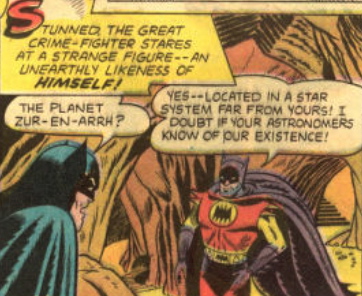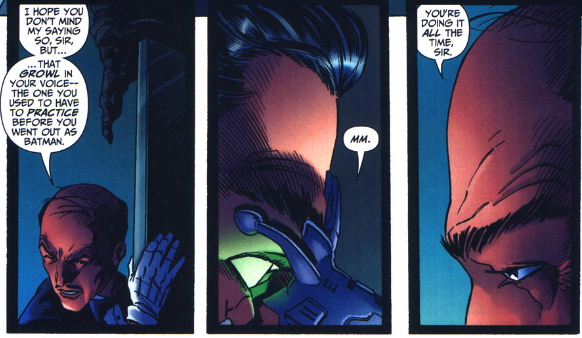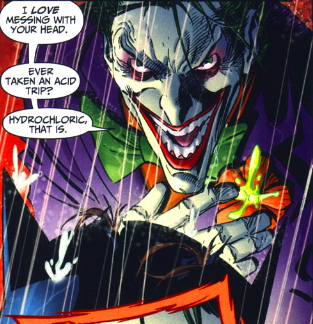Note: I am reprinting, without change, a series on Grant Morrison’s Batman work originally printed in 2013 on my old site.
We’ve discussed in detail the Batwork Grant Morrison did before his long-form Bat-epic got started. With Batman & Son, Grant Morrison’s epic begins in earnest. This arc is the first “essential” component of his 5+ year story, and from the very start he lets you know that this is not your average Batman story…Or any average comic book, even, for that matter. It’s probably my single favorite story ever, and the first three pages are part of the reason why.
When I was in college, we learned all kinds of writer tricks: Foreshadowing, misdirection, understatement, gradual exposition…And Morrison uses all of them. And many in the first few pages of Batman #655.
I’m not going to do this with every issue—it would simply take too long—but it’s worth going through this first issue page by page to get a clearer sense of what Morrison is building. This is the foundation for everything to come.
The splash page is a series of four panels. Someone is falling. Screaming. We see familiar black, thick-rimmed glasses. Someone screams, “The Commisioner’s been poisoned by the Joke!” and we see Gordon falling, and laughing. The next page is a double wide splash (but not the title page) of Joker holding an unconscious Batman in one hand, a bloody club in the other, and his helicopter in the background holding a bunch of children. “I finally killed Batman!” Joker screams, “In front of a bunch of vulnerable disabled kids!” And on the very next page, Batman pulls a gun out of his utility belt and points it at Joker….


Then on the next page, another of many full-size pages beautifully drawn by Andy Kubert, Joker is shot in the fact…But there are two Batmen. And bullet is coming from above BOTH those Batmen!
So we begin the story by falling into a confusing tangle of Batman’s greatest friend, biggest fiend, and a Batman using a gun, something The Bat has sworn never to do. (At least not since his very early days, when Bob Kane and Bill Finger created a much more violent and rough character.)
The next few pages take place on the streets of Gotham. If you’re not studying this book, you might miss the graffiti that appears all over the walls, several times: Zur En Arrh. These words will matter much later, in the first of several “climaxes” of the Morrison epic: Batman R.I.P. It’s the codeword implanted in Batman’s head, so seeing it here in the very beginning indicates that “R.I.P. plot” against Batman has already begun. Only we the readers, like Bruce Wayne himself, don’t know it. On rereading this chapter, I find myself wondering if the writing is even there at all….Or is it just an artistic way to show that Batman has been corrupted. I’m still not sure. But if the writing really is on the wall (pun intended), it seems clear that Simon Hurt had to have written it there.
*Zur En Arrh is also the name of the dimension on which Batman had Superman’s powers. This is important, as Morrison uses his time with Batman as a running commentary on comic books, super-powered beings, and the role of art in popular culture. That commentary begins in earnest next issue, as a matter of fact.

Morrison then takes us into the Batcave with Alfred, Bruce and Red Robin. We learn that Bruce’s regular speaking voice has become a “growl,” the one he “used to practice before [he] went out as Batman.”

The inability to alternate between his secret identity and his super identity will become critical over the course of the next twenty or so issues. We see Robin leaving to do his own thing and Batman getting a new Batmobile, both indications that he is becoming more isolated and is changing. All of the people close to him are telling him to go on vacation, to get away, to relax. (Commissioner Gordon talks about needing to lighten up, but he’s on Joker Serum so I’m not sure that counts.) Bruce also thinks he sees one of his enemies, but it turns out to be a normal person in a raincoat. Again, this raises the ideas of mistaken identity and the inability to see what is real.
It’s also interesting that his family is similarly affected. Robin nearly forgets to take off his mask when he goes off duty.

And thus, all the major themes for the first half of Morrison’s epic are sown in the first 15 pages of the first issue.
The next half of the book is spent introducing the villains for this particular story arc, is well as Damian Wayne, and showing Bruce Wayne doing his best to be a millionaire playboy. It isn’t as laden with thematic concepts—this is where Morrison introduces the plot. He started with Batman’s greatest villain, The Joker, finished him off in a few pages, and then moved on to something bold and different. I can’t imagine how that must have been for readers who didn’t know what would ultimately happen with Talia and Damian, and the role Bruce would play as a father. Thus, in this one issue, Morrison proved comics can be literature.
Brilliant.
Next: A little history lesson…

